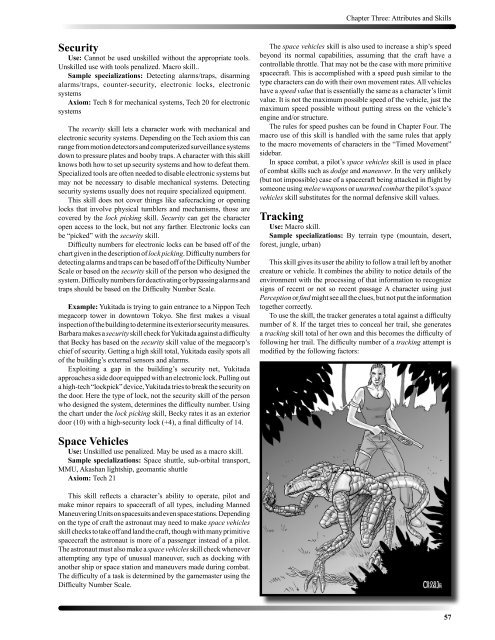Torg Player Rules
Torg Player Rules
Torg Player Rules
You also want an ePaper? Increase the reach of your titles
YUMPU automatically turns print PDFs into web optimized ePapers that Google loves.
Security<br />
Use: Cannot be used unskilled without the appropriate tools.<br />
Unskilled use with tools penalized. Macro skill..<br />
Sample specializations: Detecting alarms/traps, disarming<br />
alarms/traps, counter-security, electronic locks, electronic<br />
systems<br />
Axiom: Tech 8 for mechanical systems, Tech 20 for electronic<br />
systems<br />
The security skill lets a character work with mechanical and<br />
electronic security systems. Depending on the Tech axiom this can<br />
range from motion detectors and computerized surveillance systems<br />
down to pressure plates and booby traps. A character with this skill<br />
knows both how to set up security systems and how to defeat them.<br />
Specialized tools are often needed to disable electronic systems but<br />
may not be necessary to disable mechanical systems. Detecting<br />
security systems usually does not require specialized equipment.<br />
This skill does not cover things like safecracking or opening<br />
locks that involve physical tumblers and mechanisms, those are<br />
covered by the lock picking skill. Security can get the character<br />
open access to the lock, but not any farther. Electronic locks can<br />
be “picked” with the security skill.<br />
Difficulty numbers for electronic locks can be based off of the<br />
chart given in the description of lock picking. Difficulty numbers for<br />
detecting alarms and traps can be based off of the Difficulty Number<br />
Scale or based on the security skill of the person who designed the<br />
system. Difficulty numbers for deactivating or bypassing alarms and<br />
traps should be based on the Difficulty Number Scale.<br />
Example: Yukitada is trying to gain entrance to a Nippon Tech<br />
megacorp tower in downtown Tokyo. She first makes a visual<br />
inspection of the building to determine its exterior security measures.<br />
Barbara makes a security skill check for Yukitada against a difficulty<br />
that Becky has based on the security skill value of the megacorp’s<br />
chief of security. Getting a high skill total, Yukitada easily spots all<br />
of the building’s external sensors and alarms.<br />
Exploiting a gap in the building’s security net, Yukitada<br />
approaches a side door equipped with an electronic lock. Pulling out<br />
a high-tech “lockpick” device, Yukitada tries to break the security on<br />
the door. Here the type of lock, not the security skill of the person<br />
who designed the system, determines the difficulty number. Using<br />
the chart under the lock picking skill, Becky rates it as an exterior<br />
door (10) with a high-security lock (+4), a final difficulty of 14.<br />
Space Vehicles<br />
Use: Unskilled use penalized. May be used as a macro skill.<br />
Sample specializations: Space shuttle, sub-orbital transport,<br />
MMU, Akashan lightship, geomantic shuttle<br />
Axiom: Tech 21<br />
This skill reflects a character’s ability to operate, pilot and<br />
make minor repairs to spacecraft of all types, including Manned<br />
Maneuvering Units on spacesuits and even space stations. Depending<br />
on the type of craft the astronaut may need to make space vehicles<br />
skill checks to take off and land the craft, though with many primitive<br />
spacecraft the astronaut is more of a passenger instead of a pilot.<br />
The astronaut must also make a space vehicles skill check whenever<br />
attempting any type of unusual maneuver, such as docking with<br />
another ship or space station and maneuvers made during combat.<br />
The difficulty of a task is determined by the gamemaster using the<br />
Difficulty Number Scale.<br />
Chapter Three: Attributes and Skills<br />
The space vehicles skill is also used to increase a ship’s speed<br />
beyond its normal capabilities, assuming that the craft have a<br />
controllable throttle. That may not be the case with more primitive<br />
spacecraft. This is accomplished with a speed push similar to the<br />
type characters can do with their own movement rates. All vehicles<br />
have a speed value that is essentially the same as a character’s limit<br />
value. It is not the maximum possible speed of the vehicle, just the<br />
maximum speed possible without putting stress on the vehicle’s<br />
engine and/or structure.<br />
The rules for speed pushes can be found in Chapter Four. The<br />
macro use of this skill is handled with the same rules that apply<br />
to the macro movements of characters in the “Timed Movement”<br />
sidebar.<br />
In space combat, a pilot’s space vehicles skill is used in place<br />
of combat skills such as dodge and maneuver. In the very unlikely<br />
(but not impossible) case of a spacecraft being attacked in flight by<br />
someone using melee weapons or unarmed combat the pilot’s space<br />
vehicles skill substitutes for the normal defensive skill values.<br />
Tracking<br />
Use: Macro skill.<br />
Sample specializations: By terrain type (mountain, desert,<br />
forest, jungle, urban)<br />
This skill gives its user the ability to follow a trail left by another<br />
creature or vehicle. It combines the ability to notice details of the<br />
environment with the processing of that information to recognize<br />
signs of recent or not so recent passage A character using just<br />
Perception or find might see all the clues, but not put the information<br />
together correctly.<br />
To use the skill, the tracker generates a total against a difficulty<br />
number of 8. If the target tries to conceal her trail, she generates<br />
a tracking skill total of her own and this becomes the difficulty of<br />
following her trail. The difficulty number of a tracking attempt is<br />
modified by the following factors:<br />
57



